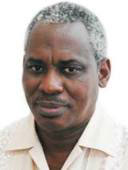Investigation finds pilot error due to poor cockpit resources management as the sole cause
PILOT error resulting from poor cockpit resources management by the pilot and co-pilot was identified as the sole cause of the crash of Caribbean Airlines Limited (CAL) Flight BW 523 which ran off the runway at Cheddi Jagan International Airport (CJIA) on July 30, 2011.

During a media briefing on the accident report which was released yesterday, Minister of Public Works, Robeson Benn who is responsible for aviation, disclosed that the team of local and international investigators had listed this as their main finding.
He stressed: “The flight crew’s indecision as to the execution of a go-around, failure to execute a go-around after the aircraft floated some distance down the runway and their (the cockpit crew) diminished situational awareness were the main contributors.”
The aircraft had no mechanical defects which could have contributed to the accident.
The entire report can be found on the website www.publicworks.gov.gy.
Benn added that the report being public and available for viewing by all interested parties may be useful to those who may want to take any sort of follow-up action based on the findings.
The Accident Investigation Team, it was disclosed, was headed by Investigator-in-Charge, Ms. Paula Mc Adam of the Guyana Civil Aviation Authority (GCAA).
The team comprised representatives from the Trinidad and Tobago Civil Aviation Authority (TTCAA), Caribbean Airlines Limited (CAL) the United States of America National Transportation Safety Board (NTSB) the Boeing Company, which is the maker of the aircraft, and the Caribbean Aviation Safety and Security Oversight System (CASSOS).
Attorney-at-law, Amanda Desir representing the Ministry took pains to point out that the report was prepared pursuant to article 26 of the Chicago Convention and as a result the sole objective had been for the prevention of accidents and incidents.
She stressed: “It was not the purpose of these investigations to apportion blame or liability.”
The investigators had added several recommendations which when implemented will help to enhance safety of aircraft on touchdown.
Lessons learnt by Guyana’s security teams and firefighters on the ground in the immediate aftermath of the crash had also been implemented by way of emergency exercise drills and these forces are as a result now better equipped to deal with emergencies.
One recommendation to the management of the CJIA is that they must set aside an easily identifiable area to provide comfort to passengers who may be in distress as well as their relatives, during an emergency.
Disclosing details on the findings, Benn disclosed that investigators had found that the ill-fated aircraft had touched down approximately 4.700 feet beyond the runway threshold, a mere 2,700 feet from the end of the runway and the crew had been unable to stop the aircraft on the remaining runway surface.
“The aircraft exited the end of the runway approximately 20 feet left of the centre line breaking through a fence and coming to rest on the bottom of a 20 feet high earth embankment. The final position of the aircraft was approximately 130 feet from the end of the paved surface and 64 feet off the extended runway centre line,” he said quoting from the report.
The aircraft broke into two sections in the vicinity of the first class bulkhead. Both engines were destroyed by the impact and foreign objects ingestion. The damage had been found to be beyond economic repair.
There had been no fatalities but one passenger suffered a broken leg which eventually had to be amputated. Several other passengers and crew suffered minor injuries during the accident and investigation.
Ms. Mc Adam said that the team interviewed the crew and none of them could give any explanation as to why the plane had landed too late on the runway.
She however disclosed that the cockpit voice recorder indicated that there was not enough coordination in the cockpit.
“During the landing and at the point of landing there was not significant interaction between the pilot and the first officer. There was a lack of awareness in the cockpit as to where the aircraft was. There was poor coordination in the cockpit during the landing. In short, there was poor Cockpit Resource Management. The pilots were not sleepy.”
She said that one recommendation the team had made was with respect to training aimed at improving Cockpit Resource Management.
“This and other recommendations have been made to the CAL and T&TCAA and we have been assured that the T&TCAA is following up on the recommendations to ensure that they are implemented,” she said.
She said that she was certain too that the CAL would take the recommendations on board since it was a business and they would want to ensure that they do things to ensure that the safety of their passengers is enhanced.
She stressed that the team had not recommended grounding of the crew or any disciplinary action because that was not its role.
She said that such actions were the prerogative of T&T CAA and CAL since they both had the responsibility of ensuring that corrective actions were taken before allowing the pilots involved in the accident to fly again.
(By Clifford Stanley)



.jpg)








